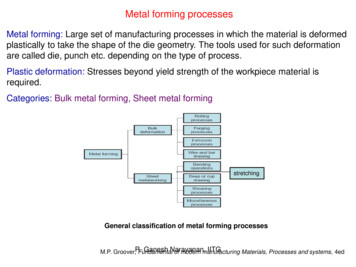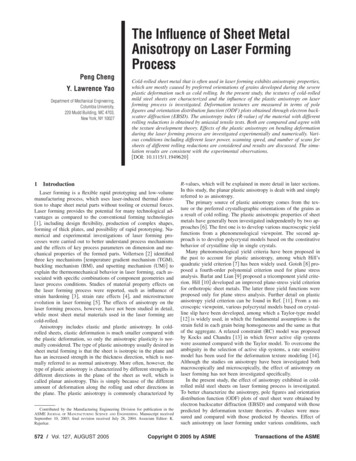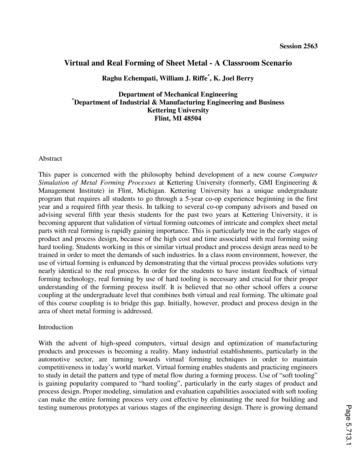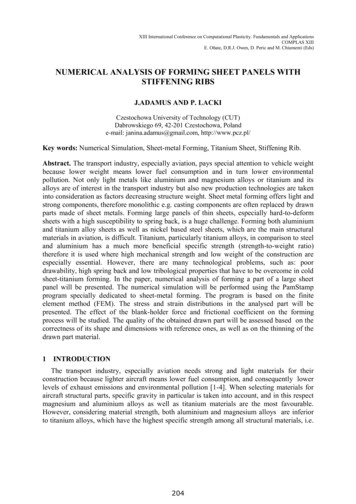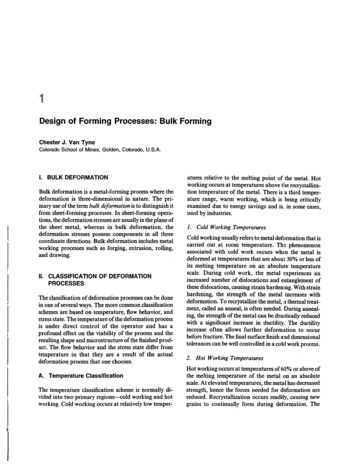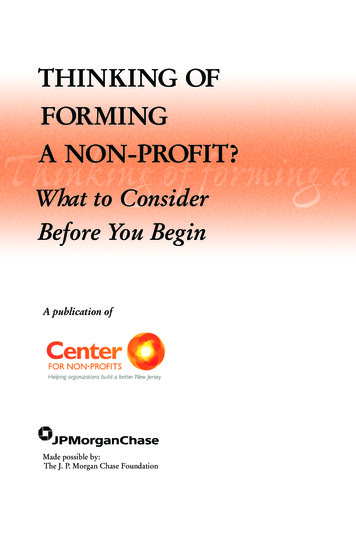
Transcription
THINKING OFFORMINGA NON-PROFIT?What to ConsiderBefore You BeginA publication ofMade possible by:The J. P. Morgan Chase Foundation
TABLE OFCONTENTS1So, You’re Thinking About Starting a Nonprofit 3What is a Non-Profit, Anyway?6First Steps for Building a Strong Base9To Be or Not to Be? The Legal Questions15Forming a Religious Institution: Legal Options17Spinning Off a New Non-Profit:The Advantages and Risks for Houses of Worship23Introduction to the Non-Profit Board25The Changing Face of the Non-Profit Sector andthe Challenges that Lie Ahead28ResourcesThinking of Forming a Non-Profit? What to Consider Before You Begin is published bythe Center for Non-Profits. The Center is a charitable non-profit umbrellaorganization providing advocacy, services, research and membership benefits toNew Jersey’s charitable groups. Copyright 2004, 2006, 2008, 2010, 2013,2014 Center for Non-Profit Corporations, Inc.Center for Non-Profits3635 Quakerbridge Road, Suite 35Mercerville, NJ 08619732-227-0800 Fax s.orgThe information contained in this publication is for informational purposes and should notbe construed as legal advice. For answers to specific questions concerning your situation,you should consult a knowledgeable attorney who can advise you regarding your particularcircumstances.
SO,YOU’RETHINKINGABOUTSTARTING ANON-PROFIT YYou’ve identified a need in the community. You want to give something back tosociety. You’ve talked to a few people and they think you have a great idea.You need to be able to receive tax-deductible donations or solicit grants fromcorporations and foundations. You’ve had experience in other organizations and wantto form a new one to fill an unmet need.These are only a few of the many possible reasons for forming a non-profit, charitableorganization. You may have even started the process, only to hit a few bumps in theroad or come up with questions that need answering. Or maybe the whole idea seemsdaunting: Which state government agency do you need to talk to? Can’t you gostraight to the IRS? What forms and reports have to be filed every year? And above all:Will forming a new organization be the most effective way to reach your goal?Now is the perfect time to take a step back. Remember that what first energized youwas a specific need, problem to solve, or issue that you felt needed attention. Youare looking for the best way to work on this issue. That is really your goal—and thefoundation for moving ahead.This publication covers some important issues to keep in mind as you decide what themost effective medium will be to reach your goal. You’ll read about what a non-profitis, some of the legal advantages and disadvantages of forming a non-profit, some ofthe requirements for forming and sustaining a non-profit, and alternatives to formingCenter for Non-Profits1
a new organization. We also discuss a few questions specific to houses of worship andfaith-based organizations. Although this book focuses primarily on 501(c)(3) organizations, there is information relevant to other types of non-profits as well.Our goal in preparing this publication is to answer basic questions about what anon-profit is and how to form one as well as portray a realistic picture of what isinvolved in getting a new non-profit up and running. Consider this your first stepin determining if a new charitable non-profit corporation is the best way for yourgroup to reach its goal. The second step is your own further research into yourcommunity, the need, and the legal and administrative issues discussed in this publication. Always consult with the appropriate professional to review your own particularcircumstances.2Thinking of Forming a Non-Profit? What to Consider Before You Begin
WHATIS ANON-PROFIT,ANYWAY?MMost people use the term “non-profit” loosely to refer to organizations such ascharities or those working for the public good. They may assume that all nonprofits have the same tax benefits, such as the ability to collect tax-deductiblecontributions. However, there are actually many types of non-profits. Trying todescribe a “non-profit” is a bit like playing “twenty questions,” where everyone triesto guess the answer by process of elimination. In the definitional sense, non-profits arecreatures of federal and state law, based in large part on what they do not or cannot do.To make matters more confusing, the term “non-profit” does not have a legalmeaning on the federal level. On the state level, it is used to describe corporations thatare organized to advance a public or community interest rather than for individualpersonal or financial gain. Therefore, non-profits may not distribute earnings or paydividends; any surplus must be used to further the organization’s mission/goals.However, all non-profits are permitted to hire paid staff to conduct their organization’s activities. In New Jersey, non-profit status exempts a corporation from Statecorporate income taxes.Depending upon their purposes, many—but not all—non-profit corporations canqualify for exemption from federal corporate income taxes. The U.S. InternalRevenue Code contains more than 25 different classifications of tax-exempt groups,including professional associations, charitable organizations, civic leagues, laborunions, fraternal organizations and social clubs, to name just a few. Depending on thecategory of the exemption, such groups are entitled to certain privileges and subject toCenter for Non-Profits3
COMPARISON OFTAX EXEMPTIONUNDER SECTION501(c)(3) VS. 501(c)(4)501(c)(3)—charitable,religious, educational,and similar purposes Donations are taxdeductibleEligible for sales taxexemptionEligible for non-profitmailing ratesLimits on lobbying; partisan political activity prohibited501(c)(4) — civicleagues, social welfareorganizations Donations are not taxdeductibleNot eligible for sales taxexemption, special mailingratesMore allowable lobbyingthan (c)(3); politicalactivity is limited, but notcompletely prohibitedcertain reporting and disclosure requirements and limitations on their activities. In certain instances, contributions to non-profit organizations are deductible fromfederal income taxes.Following is a much-simplified description of a few ofthe most common types of tax-exempt organizations.All of them are accurately described as “non-profit,” butthere are critical differences among them.Charitable Organization or Charity—refers generallyto organizations that are exempt from taxation underSection 501(c)(3) of the Internal Revenue Code.Although the word “charity” is often used as a “catchall” for simplicity’s sake, Section 501(c)(3) describesgroups organized and operated for one or more of thefollowing purposes: charitable, religious, educational,scientific, literary, testing for the public safety, fosteringnational or international amateur sports competition, orthe prevention of cruelty to children or animals. Daycare centers, food banks, low-income housing organizations, mental health organizations, United Ways, museums, theatre groups, colleges and environmental groupsare just some examples of the many types of charities.In general, 501(c)(3) organizations are divided into twocategories, “public charities” or “private foundations.”Public charities are 501(c)(3) organizations that candemonstrate that a certain part of their support (usually1/3 on average) comes from the general public or a unitof government; or organizations formed to raise moneyfor a specific school, hospital, governmental unit orpublicly supported charity. Charities are permitted tocharge fees for their services; in fact, many public charities rely on fees for a substantial part of their revenues.Contributions to public charities are usually taxdeductible, a significant privilege not granted to mostother types of organizations. Public charities are prohibited from engaging in any activities to support oroppose political candidates, but are permitted to influence legislation within legal limits.Private foundations are 501(c)(3) organizations that distribute money to fulfill a public purpose. Foundationsare subject to different laws and regulations than public4Thinking of Forming a Non-Profit? What to Consider Before You Begin
charities. Foundations must distribute a certain portion of their income for charitablepurposes and must pay an excise tax on investment income. There are strict rules andpenalties to prevent personal or financial gain by certain people, including trusteesand substantial contributors. Under most circumstances, contributions to privatefoundations are tax-deductible. Private foundations are prohibited from engaging inlobbying activities, but may contribute to charities that lobby as long as the funds arenot earmarked for lobbying purposes.Civic Leagues and Social Welfare Organizations, as described in Section 501(c)(4) ofthe Internal Revenue Code, are organizations that are created to further the commongood and general welfare of the people of the community. Examples can include civicgroups, downtown improvement associations and social action organizations. Becausethe purposes of 501(c)(3) and 501(c)(4)New Jersey 501(c)(3) Charitiesorganizations can be very similar,some organizations could potentiallyqualify for either classification. Thereare pros and cons to each structure.For example, contributions to501(c)(4) groups are usually not taxdeductible, but lobbying activities of501(c)(4) organizations are not limitedby law, and partisan political activitiesare subject to different restrictions.Trade and Professional Associations,business leagues, and the like aredescribed in Section 501(c)(6) of theInternal Revenue Code. Chambers of commerce, retail merchants associations andreal estate boards are examples of 501(c)(6) organizations. Contributions to tradeassociations are not tax-deductible as such, but may be deductible as business expenses within certain limits (membership dues used for lobbying purposes, for example,are not tax-deductible). Trade associations are not subject to legal limitations on lobbying and political activity beyond normally applicable election laws.Social and Recreational Clubs, described in Section 501(c)(7) of the Internal RevenueCode, include hobby clubs, country clubs, garden and variety clubs, amateur hunting,fishing or other sport clubs and similar groups organized primarily for recreation orpleasure and not for profit. Social clubs may not discriminate against any person onthe basis of race or color.In short, non-profit corporations are for people, to help them achieve some commonpurpose. Non-profit and charitable organizations play a vital role in the economic andsocial well being of our communities, state and nation. They provide a means for people to contribute time, resources and expertise for a greater good. The answer to the“twenty questions” may be hard to come by, but the pursuit is well worth the effort.Center for Non-Profits5
FIRSTSTEPSFORBUILDINGA STRONGBASEAs you consider starting a new organization, it’s often helpful to start with a broadview and work toward the specifics. However, you may also find that the process issomewhat circular, requiring repeated thought and attention to many issues. Thissection covers some tips and initial steps, large and small, that you should take tohelp determine whether you want to move ahead. For additional detail regardinggovernment requirements, refer to the next section, “To Be or Not to Be: The LegalQuestions,” on page 9. Keep your charitable mission in the front of your mind at all times. This may sound obvious, but it can be easy to lose sight of your overall missionamidst the details of forming a new organization, legal questions and funding issues.Always be sure that your discussions, plans and actions are mission-driven.Engage a group of interested peopleGathering a group of interested people with the knowledge and skills you need isan ongoing process. Consider people in the community or with a stake in the issue,those with knowledge or expertise about the issue, those with experience in nonprofits, budgets, marketing, etc., and also those with connections to resources.If you decide to incorporate and file for tax-exempt status, you will need to form aboard of trustees (also called a board of directors, although “trustee” is the term used6Thinking of Forming a Non-Profit? What to Consider Before You Begin
in New Jersey law). As a public benefit organization, anon-profit organization is not “owned” or controlled bythe founder, executive director or anyone else, but it isaccountable to many different constituencies. The boardwill govern the organization: set the vision, mission andstrategic plan, and hire an executive director if necessary.A founding board often does a lot of hands-on workand the board has important legal responsibilities (see“Introduction to the Non-Profit Board,” page 23), sokeep this in mind as your organization evolves.MISSIONSTATEMENTUse a journalist’s 6 Ws‚—Who, What, Where,When, Why, and hoW—to explain the purpose ofthe organization as clearlyand concisely as possible: Whydoes the organization exist? For whatgreater purpose or largergood?Draft (and Redraft!) a Program or Business PlanThis process and the document you produce will helpyou reach your goal by clarifying your objectives,activities and resources; helping to market your idea topossible volunteers, board members, staff and funders;laying out the steps you will take; and answering manyof the questions you’ll be asked by potential fundersand during the incorporation and tax-exempt processes.Do some real research into your issue, the community’sneeds and resources, successful approaches, fundingresources, others working on your (or a similar) issue,and more. Discuss everything thoroughly with yourfounding group and write: Vision and mission statements Problem statement—remember your research,don’t just say “there are homeless in our streets” Methods or activities to reach your mission and vision Budget Timeline Resources needed—financial, material, and people withspecific skills Possible resource opportunities—research and startrelationships with funding and other resources that areinterested in working with your group Whatdo you plan toaccomplish, affect, change? Whomdoes theorganization serve? Wheredoes theorganization serve? How will you accomplishthis? (specify the servicesor activities) Whenwill services beprovided, or goalreached?For example:The ABC Agency providesart and music instructionand activities to allchildren aged 3 to 18in greater Anytown, inorder to encourage theirintellectual and creativedevelopment.Also, look for possible partners and potential competitors—entities whose services you may be duplicating.Center for Non-Profits7
Be prepared to answer some questions:BEFOREYOU START Is a new organization needed? Or can you work withan existing organization? (Are the methods different?Is the geographical reach or the target populationdifferent?)Focus your thoughts/create a business plan services will yourorganization provide andwhat needs will it f ll?Are there resources (especially funders) that are interested in, better yet, committed to your organization? Are you duplicatingservices alreadybeing provided bysomeone else? If so,justify why.Do your proposed organization’s purposes and activities qualify for non-profit and for tax-exempt, 501(c)(3)status? If not, what form is best for your organization?(A for-profit? Unincorporated group? A different classification of tax exemption, such as 501(c)(4)?) Does your group have all the skills and expertise needed? For your particular cause? To manage an organization? To run a non-profit corporation? How long do you think it will take before the organization is running well? How will this be evaluated? Whatwill you do if the organization never takes off asplanned? What Whowill provide theproposed services? Whoare your potentialconsumers/constituentsand how will you reachthem? Wherewill you get thefinancial resources tostart and sustain yourorganization?(Be sure sources areconsistent withyour desired structure,such as 501(c)(3).)8Your missionIf you decide that a charitable non-profit corporation isthe best way to achieve your goal, you will have a lot ofwork ahead of you—however, if you’ve done yourhomework and keep your mission at the forefront ofyour planning, you will have built a strong base foryour new organization.Thinking of Forming a Non-Profit? What to Consider Before You Begin
TO BE ORNOT TO BE?THE LEGALQUESTIONSEditor’s note: For further discussion of the different types of non-profit organizations,please see “What is a Non-Profit, Anyway?” on page 3; this section focuses on organizations that are considering 501(c)(3) status.TThe Center for Non-Profits frequently fields the following questions, “Can Iform a non-profit corporation?” and “Should I form a non-profit corporation?” The first question can usually be answered objectively, while the secondrequires a more in-depth discussion of the organization’s objectives balanced againstthe advantages and disadvantages of forming a non-profit corporation.In New Jersey, “Can I” simply requires any lawful purpose other than financialprofit. There is a laundry list of organizations that meet that definition, some ofwhich are cited in the New Jersey statutes. Other requirements include not issuingstock, having at least 3 trustees over the age of 18 and having a registered agent inNew Jersey. For organizations contemplating 501(c)(3) status, the primary purposeshould be religious, charitable, educational, literary, scientific testing, public safety,fostering national or international sports competition, or prevention of cruelty tochildren or animals. The organization must benefit the broad public or a broad classof individuals to be eligible for 501(c)(3) status.The “Should I” question starts with a more in-depth discussion of the organization’spurposes, objectives and proposed operations. Every once in a while something isdivulged which discourages non-profit incorporation, or requires changes to ensurethat the organization is for public, rather than private, benefit. A somewhat extremeexample is, “One of the trustees will draw a salary and the organization will purchaseall supplies from that trustee’s for-profit business, who also happens to be the personCenter for Non-Profits9
the organization will rent space from. It won’t be a problem with the other twotrustees because they are passive and will never show up for meetings anyway.”Such a structure would be inappropriate because a 501(c)(3) organization is set upto benefit the public or a class of people, and NOT to benefit one individual withvarious advantages and profits (such as rent, increased business or unreasonablesalary) that are unrelated to the organization’s charitable purpose.Assuming, however, that there is a valid charitable purpose, what are the advantagesof forming a non-profit corporation? an exempt 501(c)(3) organization? Note thatforming a non-profit corporation (state level) does not automatically mean the organization is 501(c)(3) for Federal tax purposes. Organizations with gross receipts of 5,000 or more must apply to the Internal Revenue Service for recognition of taxexempt status.Advantages As a separate legal entity, incorporation inserts a legal buffer between the corporationand the trustees, officers, members, or other individuals. The assets at risk in a lawsuitor claims of creditors are the corporation’s, not the personal assets of the individualtrustees, officers, volunteers, etc. New Jersey non-profits are exempt from New Jersey corporate income tax. Non-profit organizations may be exempt from property taxes on all or part of theirreal property.Non-Profit / “can’t make a profit.”Surpluses are permitted anddesirable, but they must be used tofurther the organization’s activities Incorporation frequently elevates anorganization’s status in the eyes ofpotential donors and the public. Non-profit 501(c)(3) organizationsare exempt from federal incometaxes on income related to theorganization’s exempt purposes. Non-profit 501(c)(3) organizations are exempt from federal unemployment taxes. Non-profit 501(c)(3) organizations may collect tax deductible contributions, whichmay greatly facilitate fundraising. Non-profit 501(c)(3) status is often required toreceive grants from private foundations as well as government grants and contracts. Non-profit 501(c)(3) organizations and certain others may file for a New Jersey statesales tax exemption certificate. Non-profit 501(c)(3) organizations may be eligible for reduced postal rates.10Thinking of Forming a Non-Profit? What to Consider Before You Begin
Disadvantages If individual control and autonomy over the corporation are important, non-profitstatus is not for you. Non-profits are not “owned” by individuals or stockholders,and the CEO’s employment is subject to the pleasure of the board. Apart from the time and energy you’ll expend in planning your new organization, itcosts time and money to incorporate and meet the subsequent filing requirements.At the state level: The incorporation filing fee is currently 75.00 (you should budget 115.00, whichincludes expedited service and a certified copy).Most organizations are subject to registration and annual reporting requirementswith the New Jersey Department of the Treasury, Divisionof Revenue, and the New Jersey Office of CharitiesNobody owns aRegistration (certain religious organizations qualify for anon-profit and 5.00 incorporation fee and exemption from annual reportsno single personand charities registration; organizations that raise less thancontrols it. 10,000 in annual contributions are exempt from mandatory charities registration filing if they do not use a professional fund raiser, although they may file voluntarily).New Jersey requires a certified audit when gross revenues exceed a certainamount (currently 500,000). This requirement may necessitate budgeting forattorney or accountant fees.There may be additional state filing requirements if soliciting contributions ordoing business outside of New Jersey At the federal level:status are required to complete a FormOrganizationsfilingfor501(c)(3)1023 or 1023-EZ. To determine if you are eligible to file Form 1023-EZ, you must complete the Form 1023-EZ Eligibility Worksheet. If you answer "yes" to any of the worksheetquestions, you are eligible to apply for exemption under section 501(c)(3) using this form.The IRS requires that Form 1023 be completed and submitted electronically through Pay.gov.As of January 1, 2020 the application fee for Form 1023-EZ is 275, while Form 1023 is 600. Since 2008, the IRS has required some form of annual filing from all organizationsregardless of size. If your organization’s gross receipts are normallyless than 50,000, you will need to file an “e-postcard” (Form 990-N)online; organizations with larger budgets will file either the Form 990 orForm 990-EZ (or, for private foundations, Form 990-PF).Center for Non-Profits11
FILING FOR501(c)(3) TAXEXEMPT STATUSMAY NOT BENECESSARY IF: Organization’s grossreceipts are not normallymore than 5,000 and itspurposes are consistentwith Section 501(c)(3).Keep in mind that otherfiling or reportingrequirements may apply.Organization is churchor church-aff liated (see“Forming a ReligiousInstitution: LegalOptions,” page 15)However, you may needactual proof of exemptionto access some of the501(c)(3) benefits such aseligibility for grants, rafflelicenses, non-profit mailing rates, and others.Additionally, proof of taxexemption can increaseyour credibility withdonors and the public, soit may be worthwhile toapply. Influencing legislation is limited for public charities andprohibited for private foundations. For all 501(c)(3)organizations, partisan political activity is strictlyforbidden. It can be difficult to sustain an organization over thelong term. Funding can be unpredictable, sporadic, or inworse cases, a dry well. A newer or less establishedorganization may need to spend more time andresources on fund raising rather than on program-related activities. A more established organization may experience a loss of momentum. There may be competition for limited resources,especially in hard economic times. You need to be sure that you aren’t duplicating what anexisting group is already doing, or that there is strongjustification for the duplication. It is not uncommon for non-profits to experience“growing pains” as the organization becomes moreestablished. Consequently, early board turnover isnot uncommon. 12Although non-profits may hire staff, pay reasonablecompensation, end the fiscal year with a surplus, andretain reasonable cash reserves, organization surpluses orassets must be used to further the group's mission and maynot be used for the personal, private benefit of anyindividual. If realizing private profit is a prioirty and iffundraising and/or taxes are not an issue, then for-profitincorporation may be an alternative (note the increasingnumber of for-profit hospitals and schools).Transparency is expected and often legally requiredfor non-profits. Most financial information is apublic record, for anyone to see.There are a variety of administrative requirements, suchas by-laws, advance meeting notices, minutes, and boardelection procedures. However, these may not be a netdisadvantage because they may force the organization toadhere to good record keeping and internal management.Thinking of Forming a Non-Profit? What to Consider Before You Begin
Next StepsAfter considering the advantages and disadvantages,your next steps depend on what structure you’ve determined is right for your organization. If you decide thatincorporating a new non-profit organization is not thebest way to reach your goals, there are a variety ofoptions you can consider (see sidebar, “Alternatives toForming a New Organization”).If your group decides to work on its own and doesnot pursue a separate legal existence, the status wouldbe akin to an unincorporated association. Many smallorganizations retain this distinction, as it may not beworthwhile to incorporate.You may want to consider forming a for-profit organization, perhaps even extending that to include a nonprofit subsidiary. If you are a person who prefers tobe “in control,” a for-profit proprietorship may beamenable to carrying out your mission. Profits couldthen benefit you personally.If you have found that forming a new 501(c)(3) organization is appropriate for your purpose and activities andis the best way for your group to reach your goals,you’ll find the “Incorporation/Tax-Exemption Checklistfor New Jersey 501(c)(3) Organizations” on page 14 tobe a helpful summary of the steps needed to incorporateand apply for tax-exempt status. The resources listed onpage 28 and the other articles in this booklet will alsoprovide you with a wealth of information to get off to agood start and comply with the many requirements.Center for Non-ProfitsALTERNATIVES TOFORMING A NEWORGANIZATION Join an existing effortCreate a special programfor an existing effortStart a local chapterof a national or regionalorganizationMaintain an informalorganizationFind a fiscal sponsor foryour organizationFind an establishedorganization to sponsoryour project if the activities will be short-term(such as an emergencyfund or a specific event)Start a for-profitorganization13
Incorporation/Tax-Exemption Checklist forNew Jersey 501(c)(3) Organizations Conduct internal/external assessment(determine that incorporation/tax exemption really isnecessary, appropriate and feasible) Recruit board members(in New Jersey, need at least three; must be age 18 orolder) Register with New Jersey Office of CharitiesRegistration before soliciting donations(www.state.nj.us/lps/ca/ocp.htm#charity; ifexempt from mandatory NJ charities registration,decide whether voluntary registration is desired. Ifapplicable, research registration requirements in otherstates where fundraising may take place) Order materials from: New Jersey Department of Treasury,Division of Revenue, 609-292-9292 ed.shtmlDownload or request the New Jersey BusinessRegistration Packet, NJ-REG. You will need to fillout Public Records Filing for New Entity, which ispart of the NJ-REG packet, OR file a narrativeCertificate of Incorporation*) www.irs.govDownload SS-4, Form 1023, and Publication 557.Review requirements at www.stayexempt.org Send letter to New Jersey Department ofTreasury, Division of Taxation requestingdetermination letter recognizing organization as a New Jersey corporation, exemptfrom income tax (recommended) File for State Sales Tax Exemption Certificate (Form ST-5) with New Jersey Department of Treasury, Division of Taxation(Form REG-1E, online at www.state.nj.us/treasury/taxation) Set up a corporate records book(for minutes, board resolutions, etc.) Choose a corporate name Record minutes of first meeting of boardof trustees Check name availability(You can search for name availability at www.state.nj.us/treasury/revenue/checkbusiness.htm or call NJDivision of Revenue at 609-292-9292. Reserve corporatename for a fee, if desired.) Choose a membership or non-membershipstructure Prepare and file Certificate of Incorporation with New Jersey Department ofTreasury, Division of Revenue* File Form SS-4 with the IRS (Employer ID #)(Form is available online at www.irs.gov and may befiled online—if you are comfortable sending your socialsecurity number over the internet—by phone or fax) Prepare by-laws (to be adopted at firstorganizational meeting of board of trustees) Hold initial organization meeting(to elect officers, adopt by-laws, etc.) Prepare and file Application for Recognition of Exemption (Form 1023 or Form 1023EZ) with IRS. Use caution if using Form 1023-EZ,as many
NON-PROFIT, ANYWAY? M ost people use the term “non-profit” loosely to refer to organizations such as charities or those working for the public good. They may assume that all non-profits have the same tax benefits, such as the ability to collect tax-deductible contributions. Howeve
